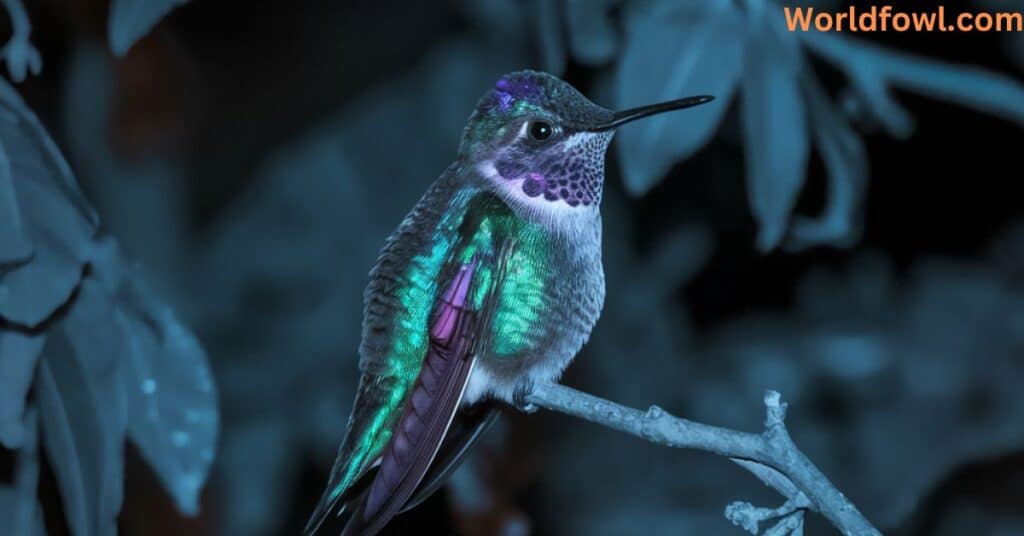Hummingbirds, those tiny, iridescent jewels of the avian world, captivate us with their daytime acrobatics and lightning-fast wings. But what happens when the sun dips below the horizon? Where do hummingbirds go at night, and what secrets does their nocturnal world hold? In this comprehensive exploration, we’ll dive deep into the mysterious nightlife of hummingbirds, uncovering fascinating facts about their sleeping habits, nighttime behaviors, and the challenges they face after dark.
Hummingbird Roosting Habits: Where Do Hummingbirds Sleep?
As twilight settles in, hummingbirds begin their nightly ritual of finding a safe place to rest. But where do hummingbirds sleep, and how do they choose their nocturnal accommodations?
Preferred Roosting Spots
Hummingbirds are particular about their sleeping arrangements. They typically seek out:
- Dense foliage in trees or shrubs
- Sheltered branches
- Thick vines
- Leaf undersides
- Small, protected crevices in tree bark
- Sheltered spots near buildings or under eaves
These spots offer protection from predators and harsh weather conditions. Some species, like the Anna’s Hummingbird, have been observed roosting on thin, bare branches, showcasing their adaptability.
The choice of roosting spot can vary depending on the species and the local environment. For example:
- Ruby-throated Hummingbirds often prefer deciduous trees with dense canopies.
- Rufous Hummingbirds may choose coniferous trees in their northern breeding grounds.
- Costa’s Hummingbirds, native to desert regions, might roost in cacti or desert shrubs.
Factors Influencing Roosting Location Choices
Several factors come into play when a hummingbird selects its nighttime roost:
- Safety: Protection from nocturnal predators is paramount. Hummingbirds are vulnerable to owls, bats, and even some nocturnal mammals.
- Shelter: Cover from wind, rain, and other elements is essential. A well-sheltered spot can help maintain body temperature during cool nights.
- Proximity to food sources: Roosting near reliable nectar sources saves energy, allowing for quick access to food in the morning.
- Temperature regulation: Some spots offer better insulation against cold nights. South-facing locations might be preferred in cooler climates.
- Familiarity: Hummingbirds often return to the same roosting sites, suggesting they remember favorable locations.
- Competition: In areas with high hummingbird populations, competition for prime roosting spots can influence choices.
- Seasonal changes: Roosting preferences may shift with the seasons, adapting to changing foliage and weather conditions.
The Process of Finding a Safe Place to Sleep
As daylight fades, hummingbirds engage in a careful selection process:
- They begin searching for suitable spots about 30 minutes before sunset.
- They may visit several potential sites before making a final decision.
- Once chosen, they may perform a series of practice landings to ensure the spot is secure.
- Some hummingbirds have been observed engaging in aerial displays or vocalizations near their chosen roost, possibly to establish territory.
How Hummingbirds Prepare for Nighttime Rest
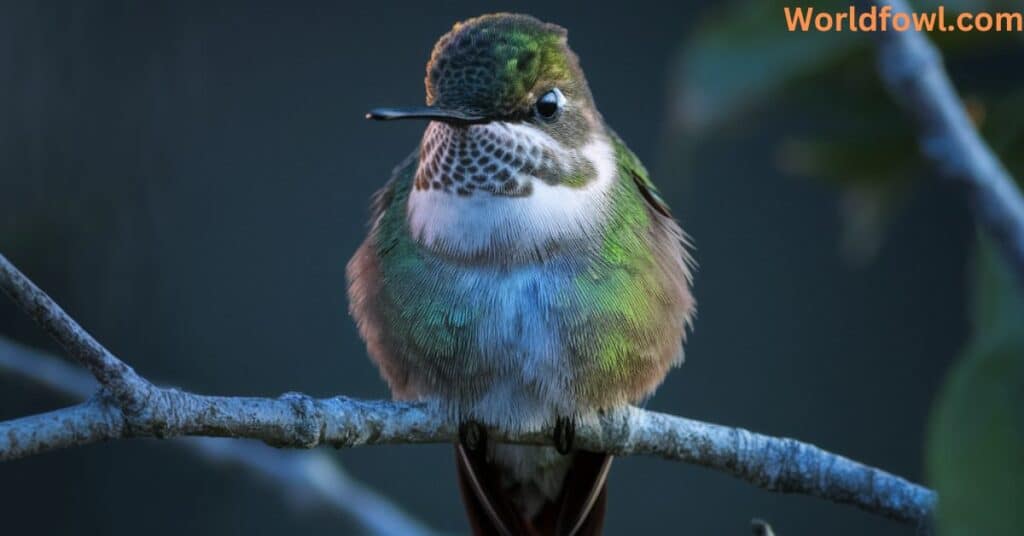
Preparing for sleep involves more than just finding the right spot. Hummingbirds:
- Fluff their feathers to trap insulating air, creating a downy layer of warmth
- Tuck their bills under their wings to reduce heat loss through their beaks
- Slow their metabolism dramatically (more on this later)
- Enter a state of torpor to conserve energy
- May rotate their body to face their tail towards potential threats, allowing for quicker escape if needed
Nocturnal Hummingbird Behavior: Do Hummingbirds Fly at Night?
One of the most common questions about hummingbird nightlife is whether these tiny birds take to the skies after dark. The answer is not a simple yes or no.
Circumstances That May Cause Nighttime Flight
While hummingbirds are primarily diurnal (active during the day), there are instances when they might fly at night:
- Migration: Some species fly at night during long migratory journeys, taking advantage of cooler temperatures and calmer air.
- Disturbance: If startled from their roost by predators or human activity, they may fly to find a new spot.
- Extreme weather: Severe conditions such as storms or sudden temperature drops might force them to seek better shelter.
- Artificial lighting: Bright lights can sometimes confuse hummingbirds, causing nocturnal activity. This is particularly common in urban areas.
- Territorial disputes: During breeding season, male hummingbirds might engage in nighttime territorial behaviors.
Exceptions to the Rule
Some hummingbird species break the mold when it comes to nighttime activity:
- The Swallow-tailed Hummingbird of South America has been observed foraging at night in urban areas with artificial lighting. This adaptation allows them to exploit a nighttime niche with less competition.
- During the breeding season, male Anna’s Hummingbirds sometimes perform courtship displays at dawn and dusk, occasionally extending into the night. These displays involve spectacular dives and vocalizations to attract females.
- The Giant Hummingbird, the largest species, has been reported to be occasionally active during moonlit nights, possibly due to its larger size allowing for better energy reserves.
you may like : Crane Vs. Heron – The Complete Comparison
Hummingbird Torpor: Nature’s Energy-Saving Mode
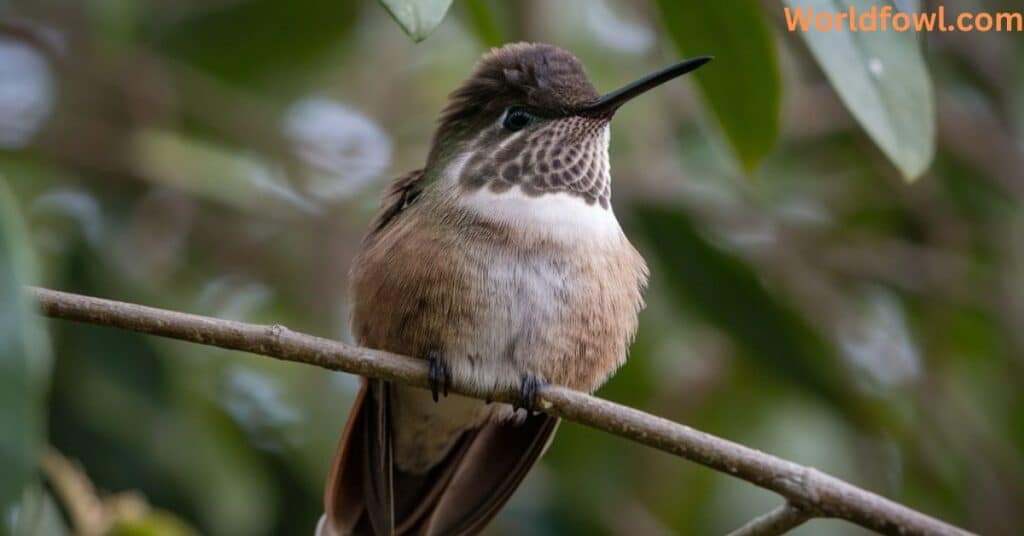
One of the most fascinating aspects of hummingbird nightlife is their ability to enter a state called torpor.
What is Torpor?
Torpor is a state of decreased physiological activity in an animal, usually characterized by a reduced body temperature, slower breathing, and lower metabolic rate. For hummingbirds, it’s a crucial survival strategy that allows them to conserve energy during the night when they can’t feed.
How Hummingbirds Enter and Exit Torpor
The process of entering and exiting torpor is remarkable:
- Entering torpor:
- Body temperature drops from about 40°C (104°F) to near ambient temperature, sometimes as low as 18°C (64°F)
- Heart rate slows from up to 1,260 beats per minute to as low as 50-180
- Breathing rate decreases significantly, with breaths becoming shallow and infrequent
- Metabolism slows to about 1/15th of its normal rate
- Exiting torpor:
- Takes 20-30 minutes
- Involves rapid muscle contractions (like shivering) to warm up
- Heart rate and breathing gradually increase
- Body temperature rises back to normal levels
- Birds may make quiet vocalizations as they awaken
Benefits of Torpor for Hummingbirds
Torpor offers several advantages:
- Energy conservation: Reduces energy expenditure by up to 95%, crucial for survival during cold nights or when food is scarce
- Survival in cold conditions: Allows hummingbirds to withstand temperatures that would otherwise be fatal
- Extended fasting ability: Enables them to survive when food is scarce, such as during migration or unexpected weather events
- Predator avoidance: The reduced need for movement during torpor may help avoid detection by nocturnal predators
| Physiological Aspect | Normal State | Torpor State |
| Body Temperature | 40°C (104°F) | Near ambient (as low as 18°C/64°F) |
| Heart Rate | Up to 1,260 bpm | 50-180 bpm |
| Breathing Rate | 250 breaths/min | Significantly reduced |
| Energy Expenditure | 100% | 5-15% |
| Metabolic Rate | 100% | About 6% |
Nighttime Feeding Habits: Do Hummingbirds Eat at Night?
The question of whether hummingbirds eat at night is intriguing, given their high-energy lifestyle and rapid metabolism.
Normal Feeding Patterns
Under typical circumstances, hummingbirds do not eat at night. Their feeding habits are closely tied to their diurnal nature:
- They feed intensively during daylight hours, visiting hundreds of flowers daily.
- A hummingbird may consume up to half its body weight in nectar each day.
- The last feeding usually occurs shortly before sunset, with birds often feeding heavily in the late afternoon.
- They enter torpor at night, reducing the need for nocturnal feeding.
you may like : 24 Yellow Birds In Ohio With Photos
Exceptions During Migration or Extreme Weather
However, there are exceptions to this rule:
- During migration: Hummingbirds may feed at night to fuel their long journeys. This is particularly true for species that undertake long-distance migrations, such as the Ruby-throated Hummingbird.
- Extreme weather: Unusually cold nights might prompt nocturnal feeding to maintain energy levels. This behavior has been observed in regions with unpredictable weather patterns.
- Artificial lighting: In urban areas, hummingbirds might feed at night near lit feeders or flowering plants. This behavior is more common in species that have adapted to urban environments.
- Prolonged daylight: In northern latitudes during summer, when daylight extends late into the evening, hummingbirds may continue feeding beyond their usual hours.
Comparison with Nocturnal Nectar-Feeding Creatures

While hummingbirds are generally not nocturnal feeders, other creatures fill this ecological niche:
Moths That Look Like Hummingbirds
Some moth species bear a striking resemblance to hummingbirds and occupy a similar ecological role at night:
- Hummingbird Hawk-Moth (Macroglossum stellatarum):
- Hovers in front of flowers like a hummingbird
- Has a long proboscis for nectar feeding
- Active during day and night
- Found in Europe, Africa, and Asia
- White-lined Sphinx Moth (Hyles lineata):
- Large wingspan (2-3 inches)
- Feeds on nectar from night-blooming flowers
- Often mistaken for hummingbirds at dusk
- Native to North and South America
- Clearwing Moths (Hemaris species):
- Transparent wings resemble hummingbird wings
- Active during the day, unlike most moths
- Mimic hummingbird flight patterns
- Found in North America and Eurasia
These moths play a crucial role in nocturnal pollination, filling the ecological niche that hummingbirds occupy during the day. Their adaptations for nighttime feeding include:
- Enhanced olfactory senses to detect nocturnal flower scents
- Larger eyes with higher sensitivity to low light conditions
- Longer proboscises to reach deep into night-blooming flowers
The coevolution of these moths with night-blooming plants highlights the importance of nocturnal pollinators in maintaining biodiversity.
Hummingbird Vision and Nocturnal Adaptation: Can Hummingbirds See at Night?
Understanding hummingbird vision helps explain their primarily diurnal nature and limited nocturnal activities.
Hummingbird Eye Structure and Function
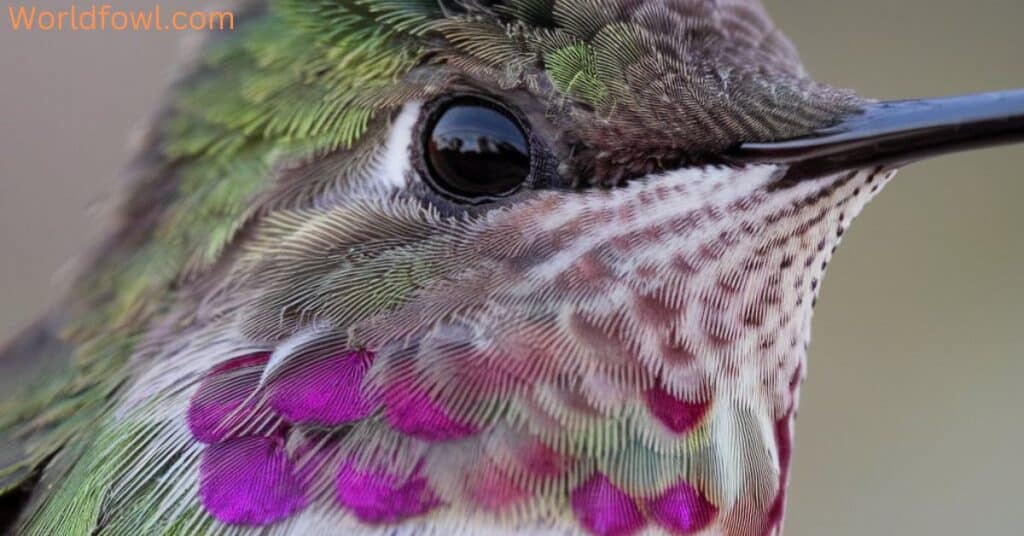
Hummingbirds have remarkable visual capabilities:
- Large eyes relative to body size, occupying about 5% of their head mass
- High density of cone cells for excellent color perception, including the ability to see ultraviolet light
- Fast visual processing to navigate during rapid flight, estimated to be about twice as fast as human vision
- Monocular vision on each side of their head, with a small area of binocular overlap in front
These adaptations allow hummingbirds to:
- Detect subtle color variations in flowers, aiding in nectar source identification
- Navigate complex three-dimensional environments at high speeds
- Spot tiny insects in mid-air for protein intake
Limitations of Hummingbird Night Vision
Despite their impressive daytime vision, hummingbirds have limited night vision:
- Fewer rod cells compared to nocturnal birds, reducing low-light sensitivity
- Color vision is less effective in dim light, potentially hampering flower recognition
- Difficulty navigating in complete darkness, unlike some nocturnal bird species
Why Hummingbirds Aren’t Nocturnal
Several factors contribute to hummingbirds’ diurnal nature:
- Evolutionary adaptations for diurnal life:
- Visual system optimized for daylight conditions
- Flight abilities suited for precise navigation among flowers
- Color perception tailored to daytime flower recognition
- Energy requirements and feeding habits:
- High metabolism requires frequent feeding, more easily accomplished during daylight
- Nectar-producing flowers typically bloom during the day
- Insect prey more abundant during daylight hours
- Predator-prey dynamics:
- Better able to detect and avoid predators in daylight
- Less competition with nocturnal nectar-feeders like moths
you may like : Can Seagulls Breathe Underwater? How Do Seagulls Avoid Drowning?
Hummingbird Migration and Nighttime Travel
The topic of hummingbird migration introduces an interesting aspect of their potential nighttime activities.
Do Hummingbirds Migrate at Night?
While not all hummingbird species migrate, those that do often undertake incredible journeys. But do they fly at night during these migrations?
- Some hummingbird species, like the Ruby-throated Hummingbird, are known to migrate at night.
- Nighttime migration is not universal among hummingbirds and can vary by species and circumstances.
- Evidence suggests that night migration is more common during long over-water flights, such as crossing the Gulf of Mexico.
Typical Migration Patterns
Hummingbird migration is a remarkable feat:
- Some species, like the Rufous Hummingbird, travel over 3,000 miles one way, from Alaska to Mexico.
- Migration routes often follow “nectar corridors” with reliable food sources.
- Most hummingbirds migrate individually, not in flocks.
- The timing of migration is often triggered by changes in daylight length rather than temperature or food availability.
Factors Influencing Nighttime Migration
Several factors can influence whether hummingbirds migrate at night:
- Weather conditions: Favorable winds and temperatures can make night flying more energy-efficient.
- Predator avoidance: Reduced risk from diurnal predators during nighttime travel.
- Cooler temperatures: Less energy expenditure in cooler night air, especially important for such small birds.
- Celestial navigation: Use of stars for orientation, similar to other migratory birds.
- Atmospheric conditions: More stable air currents at night can aid long-distance flight.
Why Do Hummingbirds Migrate at Night?
Nighttime migration offers several advantages:
- Energy efficiency: Cooler air reduces energy expenditure during flight, crucial for such small birds with high metabolic rates.
- Reduced competition: Less crowded airspace compared to daytime, reducing the risk of collisions with other birds.
- Predator avoidance: Many avian predators are less active at night, potentially increasing survival rates during migration.
- Celestial navigation: Clear view of stars for orientation, complementing other navigational cues.
- Calmer air conditions: Often more stable atmospheric conditions at night, facilitating easier flight.
you may also like : Do Robins Mate For Life? The Complete Guide To Robin Romance
Challenges Faced During Nighttime Travel
Despite the benefits, nocturnal migration poses challenges:
- Limited visibility: Difficulty spotting obstacles or predators in low light conditions.
- Reduced feeding opportunities: Most nectar sources unavailable at night, requiring careful energy management.
- Disorientation: Artificial lighting can confuse migrating hummingbirds, potentially leading them off course.
- Temperature fluctuations: Rapid changes in temperature during night flights can be challenging for these tiny birds.
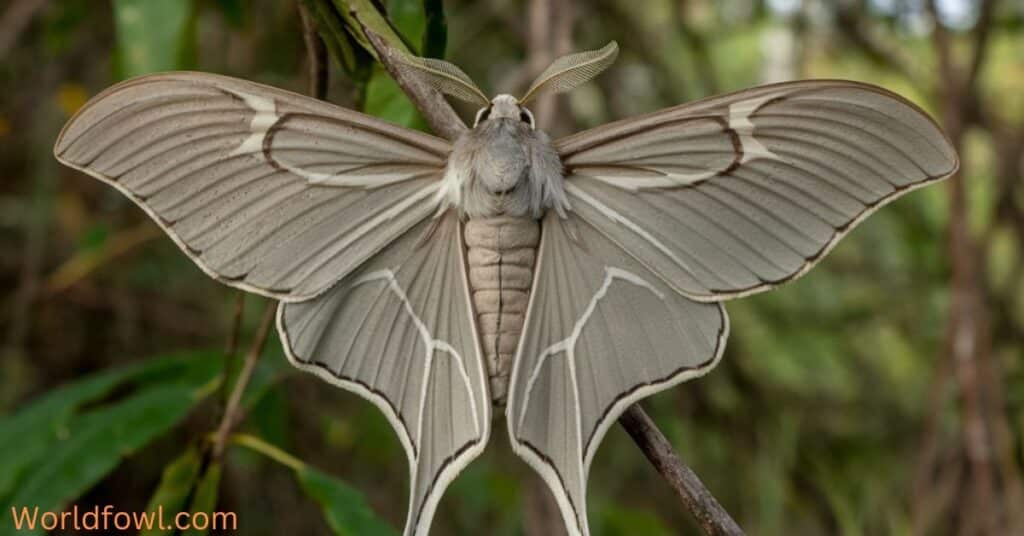
Observing Hummingbirds at Night: How Can I See Hummingbirds Flying at Night?
For bird enthusiasts eager to glimpse the nocturnal world of hummingbirds, here are some tips:
- Choose the right time: Dawn and dusk offer the best chances to observe transitional behaviors. During migration seasons, these periods may extend longer.
- Look for roosting sites: Identify potential sleeping spots during the day. Pay attention to areas where hummingbirds are active late in the afternoon.
- Use red light: If necessary, use a red-filtered flashlight to minimize disturbance. Red light is less disruptive to birds’ night vision.
- Be patient and quiet: Hummingbirds are easily startled, especially at night. Remain still and silent to increase your chances of observation.
- Focus on feeders: During migration, hummingbirds might visit feeders in low light conditions. Consider placing feeders where they can be easily observed.
- Use night vision equipment: For serious enthusiasts, night vision binoculars or cameras can aid in nocturnal observation without disturbing the birds.
- Monitor known migratory routes: During migration seasons, stake out areas along known hummingbird flyways for potential nighttime sightings.
Ethical Considerations When Observing Nocturnal Behavior
When attempting to observe hummingbirds at night, it’s crucial to prioritize their well-being:
- Avoid disturbing roosting birds; maintain a respectful distance.
- Don’t use flash photography, which can startle and disorient birds.
- Keep noise to a minimum to prevent unnecessary stress.
- Respect private property and protected areas; obtain necessary permissions.
- Avoid using artificial lights near nesting or roosting sites.
- If using feeders for observation, maintain them properly to prevent the spread of disease.
Citizen Science Projects Tracking Hummingbird Nightlife
Participate in research by joining citizen science projects:
- Project FeederWatch: Report hummingbird sightings, including unusual nighttime observations. This Cornell Lab of Ornithology project helps track bird populations and behaviors across North America.
- Journey North: Track hummingbird migration patterns. This project allows citizens to report first sightings of migrating hummingbirds, helping scientists understand migration timing and routes.
- eBird: Record hummingbird sightings and behaviors at any time of day. This global database of bird observations is a valuable resource for researchers studying bird populations and behaviors.
- Hummingbird Monitoring Network: Participate in standardized surveys to collect data on hummingbird populations and behaviors, including any nocturnal observations.
- National Audubon Society’s Hummingbirds at Home: Report hummingbird sightings and nectar sources to help scientists understand how climate change affects hummingbird behavior and migration.
By participating in these projects, enthusiasts can contribute valuable data to scientific research while enjoying their hummingbird observations.
Conservation Implications
Understanding hummingbird nightlife is crucial for their conservation.
Importance of Understanding Hummingbird Nighttime Habits
Knowledge of nocturnal behaviors helps:
- Identify critical habitats for protection, including both feeding and roosting sites
- Understand energy needs and conservation strategies, particularly during migration
- Develop more effective migration corridors that account for nighttime needs
- Assess the impact of artificial lighting and urban development on hummingbird populations
- Predict and mitigate the effects of climate change on hummingbird behavior and survival
How This Knowledge Can Aid Conservation Efforts
Practical applications of nighttime behavior research:
- Habitat preservation: Protecting both feeding and roosting sites, ensuring a comprehensive approach to habitat conservation.
- Urban planning: Designing bird-friendly lighting and structures to reduce nighttime collisions and disorientation.
- Climate change adaptation: Predicting and mitigating impacts on migration patterns and timing, which may be affected by changing day lengths and temperature patterns.
- Nectar corridor maintenance: Ensuring that migratory routes have sufficient food sources, including plants that may be utilized during twilight hours.
- Public education: Raising awareness about the importance of dark skies and reducing light pollution in key hummingbird habitats.
Protecting Hummingbird Habitats Day and Night
Conservation strategies should consider 24-hour needs:
- Preserve diverse ecosystems with both nectar sources and roosting spots
- Reduce light pollution in key habitats and along migration routes
- Educate the public about the importance of nighttime habitats and behaviors
- Implement “dark sky” initiatives in areas critical to hummingbird populations
- Encourage native plant gardening to provide natural food sources and shelter
- Support research into the effects of climate change on hummingbird behavior and migration patterns
Case Study: Urban Hummingbird Conservation
In San Francisco, researchers studied Anna’s Hummingbirds adapting to urban environments. They found that:
- Urban hummingbirds were more likely to be active in low light conditions due to artificial lighting.
- Roosting sites near artificial light sources were less preferred, highlighting the need for dark refuges in urban areas.
- Urban plants flowering outside of natural schedules due to artificial lighting and warmth were affecting hummingbird feeding patterns.
This study led to recommendations for urban planners and homeowners:
- Create “dark zones” in parks and gardens
- Use directional, warm-colored lighting to minimize impact on birds
- Plant native species that provide natural nectar sources and roosting spots
By implementing these recommendations, the city aims to create a more hummingbird-friendly urban environment that respects the birds’ natural rhythms.
Conclusion
The nightlife of hummingbirds, while less visible than their daytime antics, is a crucial aspect of their survival and behavior. From their remarkable energy-saving torpor to the occasional nocturnal flights during migration, hummingbirds have adapted to navigate the challenges of darkness.
As we’ve explored, hummingbirds go to great lengths to find safe roosting spots at night, carefully selecting locations that offer protection and proximity to resources. While they primarily sleep at night, entering a state of torpor to conserve energy, some species and individuals may engage in nocturnal activities under specific circumstances.
Understanding where hummingbirds sleep, how they behave at night, and the challenges they face during darkness is not just a matter of curiosity. This knowledge is vital for conservation efforts, helping us protect these magnificent creatures throughout their entire life cycle, day and night.
The intricate adaptations that allow hummingbirds to thrive in a world that never truly sleeps are a testament to the wonders of evolution. From their specialized vision to their ability to enter torpor, these tiny birds have developed remarkable strategies to survive the night.
As we face global challenges like climate change and habitat loss, our understanding of hummingbird nightlife becomes increasingly important. By considering their 24-hour needs in conservation planning, we can better ensure the survival of these charismatic birds for future generations to enjoy.
By continuing to study and appreciate the secret nightlife of hummingbirds, we not only satisfy our curiosity about these fascinating creatures but also contribute to their protection. Every observation, every piece of data collected, adds to our collective knowledge and informs conservation strategies.
As we move forward, let us remember that the world of hummingbirds extends beyond the daytime spectacle we typically observe. Their nocturnal world, though hidden from our usual view, is equally important and worthy of our attention and protection.
FAQs
Are there any truly nocturnal hummingbird species?
While no hummingbird species is entirely nocturnal, some, like the Swallow-tailed Hummingbird, have been observed foraging at night in urban areas with artificial lighting. However, this behavior is an adaptation to urban environments rather than a natural nocturnal lifestyle.
How long do hummingbirds sleep each night?
Hummingbirds typically sleep for 8-16 hours per night, depending on the season and available daylight. During this time, they often enter a state of torpor to conserve energy.
Can artificial lighting affect hummingbird behavior at night?
Yes, artificial lighting can significantly impact hummingbird behavior. It can disrupt natural sleep patterns, cause confusion during migration, and occasionally lead to nighttime feeding or activity. In urban areas, some hummingbirds have adapted to take advantage of artificial light sources for extended foraging.
Do hummingbirds dream?
While it’s difficult to know if hummingbirds dream in the way humans do, studies have shown that birds do experience REM sleep, which is associated with dreaming in mammals. However, given the state of torpor that hummingbirds enter, their sleep patterns may be quite different from other birds.
How do weather conditions impact hummingbird nighttime habits?
Extreme weather can force hummingbirds to seek better shelter or even feed at night to maintain energy levels. Cold temperatures may cause them to enter deeper states of torpor. During migration, weather patterns can influence whether hummingbirds choose to fly at night.

Henry James is a seasoned blogger and a passionate storyteller on “World Fowl.” With years of experience crafting engaging content, he brings a unique blend of expertise and creativity to his writing. Henry specializes in exploring diverse topics with depth and clarity, captivating readers worldwide.

